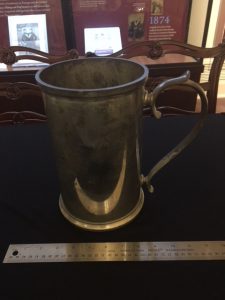Liquid Standard Presented to UNC in 1883

Liquid Standard Presented to UNC in 1883. Courtesy of North Carolina Collection, Wilson Library, UNC Chapel Hill. [1]
In order to understand the placement of this piece in Chapel Hill’s food puzzle, it is important to first set the stage with an understanding of measurement standardization in the time period. The U.S.’s 1875 signing of the Treaty of Meter represented a step towards the utilization of a joint metric system. The year 1893 marked official embracement of developed metric standards in the U.S [2]. When relating this to Chapel Hill, the U.S. Bureau of Weight and Measures’ presentation of the object depicted to UNC was in the year 1883, which falls between the two historical date of 1875 and 1893. This shows a local on-campus expansion effort in the 19th century, as Chapel Hill began the steps to standardize its measurement. By tying this Chapel Hill artifact to a national movement of the time period, new insight on Chapel Hill’s food culture is brought to the forefront.
From recipes to menus, measurement plays a crucial role in food. However, in order for the nuances of food to truly culminate into a historical narrative, the food itself must be shaped by the people that consume it. This is where standardization comes into play. Standardized measurement techniques in Chapel Hill would allow for recipes to break the bounds of personal cooking methods and forge a new frontier of expansion. Increased cooking accuracy stemming from reliable measuring tactics would lead to creative culinary development throughout the area. Meanwhile, people could now more easily utilize the shared recipes of others by following a uniform method of measure for their ingredients. Recipes that were once confined to the kitchens in which they were concocted now found themselves in local restaurants and households throughout Chapel Hill. This creative expansion stemming from the use of uniform measurement turns the page on a new chapter in Chapel Hill’s food story.
Footnotes
[1] Liquid Standard Presented to UNC in 1883. Courtesy of North Carolina Collection, Wilson Library, UNC Chapel Hill. https://dc.lib.unc.edu/cdm/singleitem/collection/keepsakes/id/520/rec/80
[2] The United States and The Metric System. Nist.gov. 1997. 2002, Accessed 2 Oct. 2018. https://www.nist.gov/sites/default/files/documents/pml/wmd/metric/1136a.pdf
Written By Adam Dietrich
|
|
